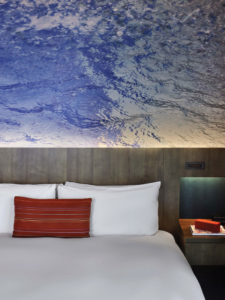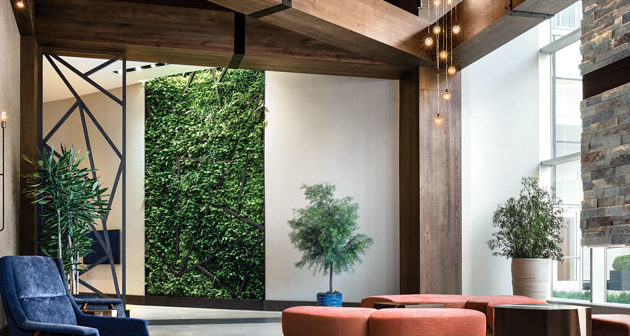NATIONAL REPORT—While humans have evolved to become largely indoor creatures, people still have a deep connection to nature. The sight of a vivid sunset, the sound of waves steadily crashing on the beach, the smell in the morning air when dew clings to leaves and grass—all evoke a peaceful, calming sensation. It’s no surprise then that architects and designers are incorporating nature into indoor spaces, exploring the relationship between outside and in, through biophilic design—and hospitality is no exception.
“Clients, developers, operators and brands are increasingly becoming more aware of the importance of creating healthier and productive environments. Not only are we seeing this uptick in our hotel and resort design, but we are seeing this across our wide range of practice areas in the firm,” said Steven Upchurch, managing director/principal, Gensler.

At East Miami, the photographic Water series was fabricated into a wallcovering, bringing the outside in.
Photo: Eric Laignel
For his part, George Fleck, VP of global brand management & marketing, Marriott International, noted that Westin Hotels & Resorts—a brand that considers biophilic design part of its ethos—made a commitment to biophilic design six years ago, and it’s not alone. “More and more brands in and out of the hospitality space are embracing biophilia as the gains in focus, creativity, productivity and overall health become more commonly known, and as more companies try to break into the wellness space,” he said.
Why? The answer is simple. “Happy people generate more revenue,” said interior designer Clodagh, principal of Clodagh Design. “Biophilic installations help to promote happiness and relaxation… The power of the wellness movement has provoked the influx of a biophilia movement. Biophilia has been scientifically proven to have a positive effect on body and mind. Even a wallcovering depicting birch trees energizes and grounds the guests.”
She continued, “Often, when I ask people where they are happiest, they answer, ‘My garden,’ ‘A walk on the beach,’ ‘A stroll under a canopy of trees.’ Nature is boundless and generous, so we incorporate both large and small indoor gardens, or photographs of living trees and plants and water, to tap into that nostalgia and sense of place.”
Fleck agreed. “For Westin, the incorporation of biophilic design principles supports the brand’s commitment to our guests’ well-being,” he said. “The concept of biophilic design is based on findings that people have a biological need to connect with nature physically, mentally and socially, and that the connection impacts personal well-being, productivity/ability to concentrate, how we learn, and reduces stress and irritability. Research also shows that access to nature, even in indoor environments, has a positive influence on behavior. As travelers increasingly prioritize time outdoors, they are also increasingly valuing opportunities to experience the outdoors within our hotels.”
Biophilic design can increase guest satisfaction—but that’s not all. “While guest satisfaction is always important for encouraging repeat business, the psychological benefits are paramount,” Upchurch said. “Emotional attachments to places where we have achieved a sense of well-being are critical. Places where we can feel we can escape and be contemplative are important to guests’ overall well-being.”
“And, from a financial standpoint, incorporating biophilia can increase a hotel’s bottom line: Guests are willing to pay a premium for well-being and biophilic design, granting an excellent opportunity for hotels to improve the guest experience while increasing RevPAR,” Fleck said. “Additionally, biophilic design is a sustainable, energy-efficient solution that can typically reduce operating costs.”
And the benefits aren’t just for guests. “Associate satisfaction is another important benefit,” Fleck said. “In professional settings, biophilic design drives improved attentiveness, heightened energy levels, and job satisfaction, in addition to enhanced overall well-being.”
“I like to introduce biophilia in the staff lounge even if it is as simple as having a video installation of a lovely outdoor garden featuring trees and the sound of water,” Clodagh said. “The rich green color of the plants elevates the heart of the space.”
How can hotels incorporate biophilic design? “Orienting building corridors, interior public spaces, guestroom fenestration to the site’s natural environments and ecosystem are key,” Upchurch said. “Starting with a plan that addresses the benefits of the natural exterior elements—trees, lakes, mountain vistas, the beach—is often the best place to start. In renovations, it’s often difficult to address these elements given existing conditions, but solving these can be the most innovative ways to achieve success.”
“At Six Senses Kaplankaya, we created an alchemy bar as part of Six Senses’ wellness workshop program,” Clodagh said. “Even before guests become involved with the fascinating process, the atmosphere of the mixing area wows them. Under expert guidance, the guests work with a variety of herbs, fruit and spices that are displayed in the room, including a ‘living wall’ of herbs. Guests smell the uplifting aromas and create individual blends for body scrubs, face and hair masks and lip balms. We also created a moon garden with night-scented jasmine, and a chromatherapy garden planted in indigo and lavender for calming the mind.”
Of course, she noted, this was a generously sized property. But, it’s still possible to do in a more compact space. “At East Miami, behind guestroom beds, my photographic Water series was fabricated into a wallcovering, bringing the outside in. This photograph was taken just outside the hotel, so its context to the property is also important.”
For its part, Westin reflects three core principles of biophilia: nature in the space (inclusion of natural materials and elements in their true form to integrate nature into the space); nature of the space (creation of protected, intimate spaces that offer refuge as well as elevated/expansive vantage points that provide perspective); and natural analog (use of materials and patterns that evoke natural imagery).

The Waldorf Astoria Beverly Hills provides balconies for every suite with views of the Santa Monica Mountains. Photo: By William Rust, Courtesy of Gensler
“With all of Westin’s properties, we integrate local culture and natural surroundings into the biophilic designs to provide guests with a naturally curated experience highlighting the nature around them,” Fleck said. “For example, one of Westin’s newer properties, the five-story, 116-room Westin Buffalo in Buffalo, NY, incorporates planted walls, soaring banks of windows and exposed wooden beams into its common areas, and decorates its guestrooms with carpets, walls and art suffused with earthy tones and replicating patterns of nature. The Westin Hapuna Beach Resort boasts a custom living wall and vertical garden that brings the island’s flora and fauna indoors, while colors found in nature inspired the sophisticated palette, coupled with natural materials and patterns that add textural layers to the interior design.”
Of course, biophilic design isn’t without its challenges. “Maintenance of indoor living plants is challenging unless hotels work with qualified specialists who understand irrigation,” Clodagh said. “Just as we give an environmental cleaning manual to our clients, we like the specialists to give a maintenance schedule or set up a maintenance program with the installer. Dead and dying plants are bad feng shui.”
“Some of the biggest challenges are tackling renovations of complex, antiquated structures,” Upchurch added. “This includes master planning, architecture and interior design for resorts, private clubs and hotels that may not capitalize on the natural synergies of the environment. To get around these challenges, it’s best to kick off the project with the owner, developer, operator and our integrated team of architects, interior designers and landscape architects. We are doing this now on a large-scale golf resort redevelopment project at Grand Palms in Pembroke Pines. We took a similar approach when we kicked-off the Queen Mary Entertainment District in Long Beach, CA.”
What does the future hold? “We anticipate that the local natural environment will play an increasingly important role in design, through the use of regionally relevant materials and color tones,” Fleck said.
Upchurch added, “Guests will increasingly continue to demand connectivity to nature during their stay for a sense of healing. With an anticipated 70% of the world’s population expected to live in cities, the challenge for connectivity to nature and healing spaces becomes even greater in biophilic design in urban hotels and resorts… Biophilic design will continue to grow in influence as more people realize the many benefits it provides, and this will emerge in our homes and workplaces as well.” HB


